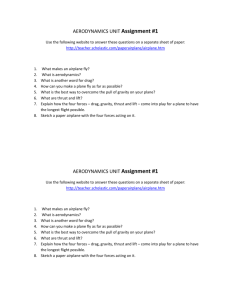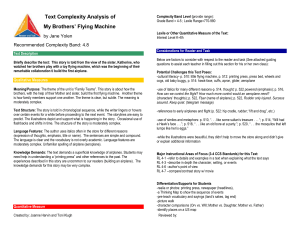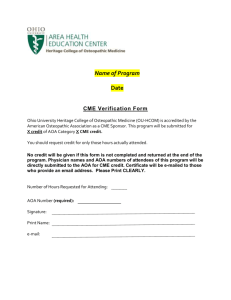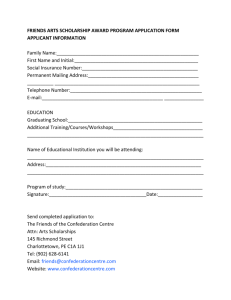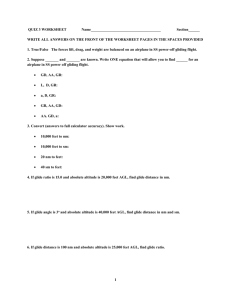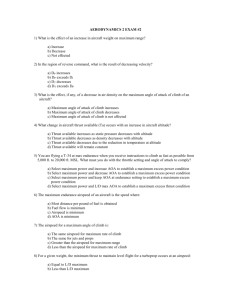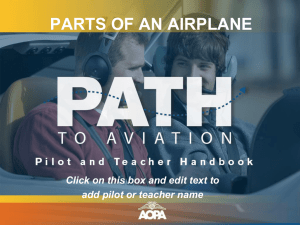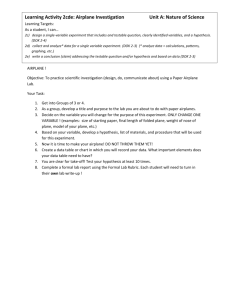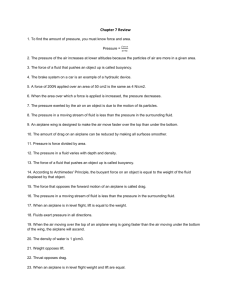Chapter 7 : Aircraft Performance
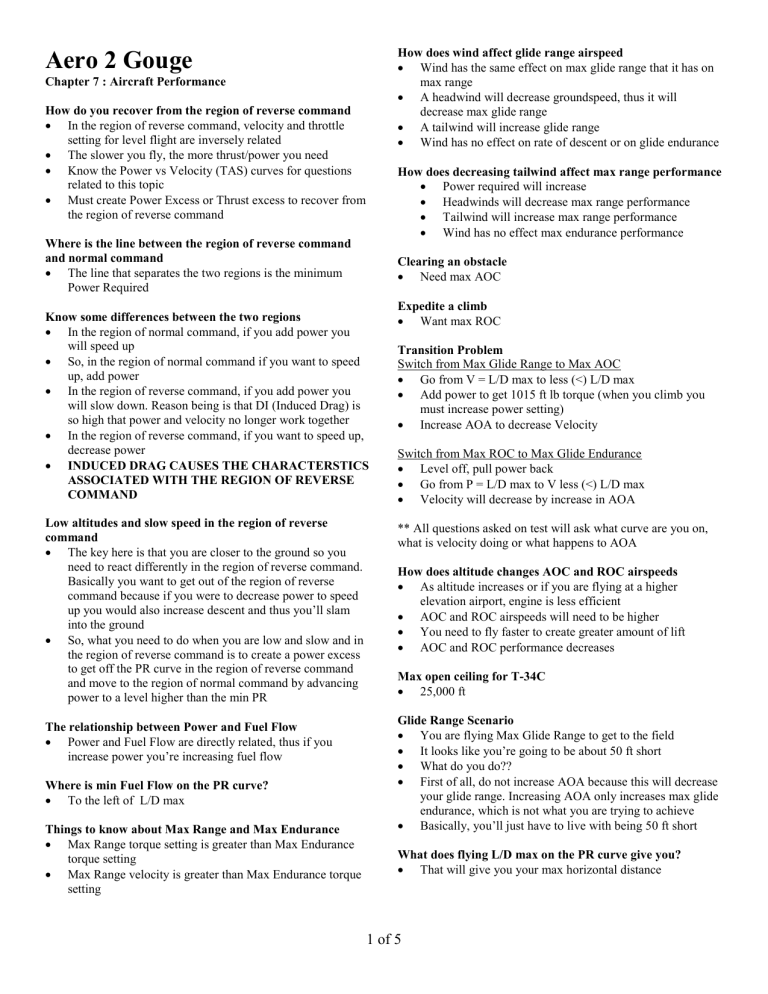
Aero 2 Gouge
Chapter 7 : Aircraft Performance
How do you recover from the region of reverse command
In the region of reverse command, velocity and throttle setting for level flight are inversely related
The slower you fly, the more thrust/power you need
Know the Power vs Velocity (TAS) curves for questions related to this topic
Must create Power Excess or Thrust excess to recover from the region of reverse command
Where is the line between the region of reverse command and normal command
The line that separates the two regions is the minimum
Power Required
Know some differences between the two regions
In the region of normal command, if you add power you will speed up
So, in the region of normal command if you want to speed up, add power
In the region of reverse command, if you add power you will slow down. Reason being is that DI (Induced Drag) is so high that power and velocity no longer work together
In the region of reverse command, if you want to speed up, decrease power
INDUCED DRAG CAUSES THE CHARACTERSTICS
ASSOCIATED WITH THE REGION OF REVERSE
COMMAND
Low altitudes and slow speed in the region of reverse command
The key here is that you are closer to the ground so you need to react differently in the region of reverse command.
Basically you want to get out of the region of reverse command because if you were to decrease power to speed up you would also increase descent and thus you’ll slam into the ground
So, what you need to do when you are low and slow and in the region of reverse command is to create a power excess to get off the PR curve in the region of reverse command and move to the region of normal command by advancing power to a level higher than the min PR
The relationship between Power and Fuel Flow
Power and Fuel Flow are directly related, thus if you increase power you’re increasing fuel flow
Where is min Fuel Flow on the PR curve?
To the left of L/D max
Things to know about Max Range and Max Endurance
Max Range torque setting is greater than Max Endurance torque setting
Max Range velocity is greater than Max Endurance torque setting
1 of 5
How does wind affect glide range airspeed
Wind has the same effect on max glide range that it has on max range
A headwind will decrease groundspeed, thus it will decrease max glide range
A tailwind will increase glide range
Wind has no effect on rate of descent or on glide endurance
How does decreasing tailwind affect max range performance
Power required will increase
Headwinds will decrease max range performance
Tailwind will increase max range performance
Wind has no effect max endurance performance
Clearing an obstacle
Need max AOC
Expedite a climb
Want max ROC
Transition Problem
Switch from Max Glide Range to Max AOC
Go from V = L/D max to less (<) L/D max
Add power to get 1015 ft lb torque (when you climb you must increase power setting)
Increase AOA to decrease Velocity
Switch from Max ROC to Max Glide Endurance
Level off, pull power back
Go from P = L/D max to V less (<) L/D max
Velocity will decrease by increase in AOA
** All questions asked on test will ask what curve are you on, what is velocity doing or what happens to AOA
How does altitude changes AOC and ROC airspeeds
As altitude increases or if you are flying at a higher elevation airport, engine is less efficient
AOC and ROC airspeeds will need to be higher
You need to fly faster to create greater amount of lift
AOC and ROC performance decreases
Max open ceiling for T-34C
25,000 ft
Glide Range Scenario
You are flying Max Glide Range to get to the field
It looks like you’re going to be about 50 ft short
What do you do??
First of all, do not increase AOA because this will decrease your glide range. Increasing AOA only increases max glide endurance, which is not what you are trying to achieve
Basically, you’ll just have to live with being 50 ft short
What does flying L/D max on the PR curve give you?
That will give you your max horizontal distance
Glide Range vs Glide Endurance
Glide range
Min angle of descent
Greatest factor affect it is a feathered prop
Glide Endurance
Min rate of descent
Has lower horizontal velocity, higher AOA, and slower rate of descent
Chapter 8 Aircraft Control Systems
3 types of controls made simple
Longitudinal Control
LOLA
Elevator
Pitch
Lateral Control
LALO
Ailerons
Roll
Directional Control
LOVE
Rudder
Yaw
Aerodynamic Balance
Used to keep control pressures associated with higher velocities within reasonable limits
T-34C:
Elevator & Rudder
shielded horn provides
Aerodynamic Balance
Ailerons
overhang provides
Aerodynamic Balance
The point of using Aerodynamic Balancing is to match
Center of Gravity (CG) and Aerodynamic Center (AC) to keep the aircraft stable
Mass Balance
Used to locate the CG on the hingeline
Places weights inside the control surface in the area forward of the hingeline
T-34C:
Elevator & Rudder
horn
Ailerons overhang mass added in the shield
mass added to the
Trim Tabs
Primary reason is the reduce pressure
Secondary reason we have them is to provide control feel
For trimming, trim tabs must always be moved in the opposite direction as the control surface. Do not confuse this with what happens automatically such as the case with servo and anti-servo or neutral
Trim Tabs that are used for Artificial Feel
Servo Trim Tab
2 of 5
Used in ailerons
Moves in the opposite direction as the aileron
Anti-Servo Trim Tab
Used in the rudder so you don’t overcontrol (since legs are normal strongest part of the body)
Moves in the same direction and at a faster rate
Thus the more that a rudder pedal is pressed, the great the resistance the pilot will feel
Neutral Trim Tab
Maintains a constant angle to the elevator
Uses a bobweight and downspring
The downspring increases the force required to pull the stick aft at low airspeeds
The bobweight increases the force required to pull the stick aft during maneuvering flight
What kind of control systems are on the T-34C?
Conventional control systems
Chapter 9 : Stability
What is positive static stability?
Tendency of an object to return to original position
For ex: tendency of an airplane to return to equilibrium flight
What is neg. static stability?
Initial tendency of an object to continue moving away from original position
For ex: tendency of airplane to continue moving away from equilibrium flight following a disturbance
Stability vs Maneuverability
Inversely related
Longitudinal Static Stability
If a component’s aerodynamic center is behind the airplane’s center of gravity the component will be a positive contributor to longitudinal static stability
If a component’s aerodynamic center is in front of the airplane’s center of gravity the component will be a negative contributor to longitudinal static stability
The horizontal stabilizer is the greatest positive contributor to longitudinal static stability
Wing Sweep
Sweeping the wings back is a positive contributor to longitudinal static stability
Directional Static Stability
Stability of the longitudinal axis around the vertical axis
The vertical stabilizer is the greatest positive contributor to directional static stability
Lateral Static Stability
Stability of the lateral axis around the longitudinal axis
Dihedral wings are the greatest positive contributor to lateral static stability
Directional Divergence
Reaction to an initial side slip results in an increase in sideslip
Caused by negative directional stability
Spiral Divergence
Occurs when an airplane has strong directional stability and weak lateral stability
Dutch Roll
Occurs when an airplane has weak directional stability and strong lateral stability
Directional Divergence vs. Spiral Divergence
Know that these two are NOT, I repeat are NOT opposites
Proverse Roll
You’ve put in a yaw and the airplane gives you a roll in the same direction as it is yawing
Airplane is reacting to something you did
Adverse Yaw
You’ve put in a roll and the airplane gives you a yaw away from the direction of aileron roll input
Airplane is reacting to something you did
P-Factor
Easy description: how thrust lines line up with relative wind
Remember prop blade turns clockwise
If thrust lines are level with relative wind
No P-Factor
If relative wind is below your thrust line
Low speed P-Factor
Downgoing blade creates more thrust
If relative wind is above your thrust line
High speed P-Factor
Upgoing blade creates more thrust
Side slip
Gust of wind blowing you off of your flight path
If you didn’t have vertical stabilizers, you’d keep going off of flight path. Vertical stabilizers are what bring you back.
How do you prevent from going off runway on take off?
Compensate by using right rudder
Slip stream swirl is what causes you to go off to yaw to the left
Chapter 10 : Spins
Know the CD CL curves vs AOA
Draw it in the space below for study purposes
3 of 5
Requirements for spins
Stall the airplane
Yaw for autorotation
Questions on test from the graph above
Which wing produces more lift?
Which wing produces more draft?
Which wing produces higher AOA
Upgoing
Downgoing
Downgoing
What gauges are we concerned with for spin indication?
Altimeter
Airspeed
AOA
Turn Needle
Erect Spin
Nose down, upright attitude, positive G’s
Altimeter : rapidly decreasing
Airspeed : 80 to 100 knots
AOA : pegged at 30 units
Turn Needle : pegged in direction of spin
Inverted Spin
Nose down, upside down attitude, negative G’s
Altimeter : rapidly decreasing
Airspeed : zero
AOA : 2 to 3 units
Turn Needle : pegged in direction of spin
Flat Spin
Nose down, upright attitude, transverse G’s (eyeballs out
G’s)
Altimeter : rapidly decreasing
Airspeed : zero
AOA : pegged at 30 units
Turn Needle : pegged in direction of spin
How to recover from spin
Reduce AOA
Give opposite rudder based on turn needle
What is an aggravated spin?
You did not step on opposite rudder during recovery from spin
What is a progressive spin?
You did not get AOA below CL max
Chapter 11 : Turning Flight
Upper Load Factor
Max load factor that airplane can withstand without structural failure
If your at Upper Load you are broke
Elastic Limit
Max load factor that may be applied to a component without permanent deformation
If your at Elastic Limit you are bent
Limit Load Factor
Greatest load factor that an airplane can sustain without any risk of permanent deformation
If your at Limit Load you at risk of being bent
In a turn, what happens to lift?
Lift is reduced and the lift vector now has vertical and horizontal components, meaning you have less vertical lift to overcome weight
So, in a turn you must increase power and increase AOA to overcome weight
Is Drag affected by AOA?
Yes, because in the formula CL is present and AOA affects
CL
What is service life?
The number of applications of load or force that a component can withstand before it has the probability of failing
Not known as service strength
What causes creep?
High temps
High stress
Know limit loads for T-34C with no flaps
4.5 G’s -2.3 G’s
Ultimate limit load for T-34C
Limit Load x 1.5
4.5 G’s x 1.5 = 6.75 G’s
Know VN / VG Diagrams
Weight, Altitude & Configuration remain constant
If they are not constant you will need a new graph because the above 3 affect your safe flight envelope
Flaps have the greatest effect on enlarging or shrinking the safe flight envelope
Asymmetrical Loading
Refers to the uneven production of lift on the wings of an airplane
Caused by a rolling pullout, trapped fuel, or hung ordinance
What happens to G’
Reduced to 2/3
3 G’s
Lift is also reduced to 2/3 of the normal limit load factor
Gust Loading
Refers to the increase in the G load due to the vertical wind gusts
Limit load factor is reduced to 2/3 of normal
3 G’s for T-34C
4 of 5
Max Air Penetration Speed for T-34C
195 KIAS
Maneuver Speed
135 KIAS
Fly this speed through turbulence so you do not run the risk of overstressing airplane
This is the intersection of Accelerated Stall Lines and your
Limit Load on the VN/VG Diagram
Also referred to as the Optimum Air Penetration Speed
What happens to Limit Load Factor when Gross Weight increases?
Limit Load Factor decreases, thus shrinking the safe flight envelope
Standard Rate Turn for T-34C
3 deg of turn are completed every second
Rough estimate is an angle of bank equal to 15-20 percent of airspeed
Equals two needle widths deflection on the turn needle
Half – Standard Rate Turn is equal to one needle width deflection on turn needle
During takeoff which force is most out of balance?
Thrust
Redline airspeed for T-34C
280 KIAS
240 KIAS
20,000 ft above 20,000 ft
What factors affect redline airspeed?
Altitude
Configuration
Critical Mach Number
Turn Radius vs Turn Rate
Increase airspeed, increase turn radius, decrease turn rate
(slip)
Increase angle of bank, decrease turn radius, increase turn rate (skid)
Both independent of weight
Slip
Used on purpose
You are not using enough opposite rudder
Wing down, opposite rudder, ball on inside of turn
Step on the ball to correct
Skid
Most dangerous
Using too much rudder
Ball on the outside of turn
Step on the ball to correct
Chapter 12 : Takeoff and Landing
Why is the VLDG formula greater (1.3 instead of 1.2)?
To provide more cushion
Know how variables in the landing and takeoff formulas will affect velocity and distance.
I will leave some space in case you want to write them down
Rolling friction equation
4 factors that affect Coefficient of Friction
Runway surface
Runway condition
Tire type
Degree of brake application
Distance Equations
Takeoff:
(T-D-FR) is net accelerating force (second biggest factor)
Weight is the biggest factor
Landing:
(FR+D-T) is the net decelerating force (second biggest factor)
Weight is the biggest factor once again
Mechanical Braking
Use reverse thrust (beta) first until you slow down a little then use brakes
Beta occurs through the use of negative pitch angle on the prop blades
Aerodynamic Braking
Accomplished by increasing parasite drag on the airplane by holding a constant pitch attitude after touchdown and exposing more of the airplane’s surface to relative wind
Drag chutes, spoilers, speed brakes
Hydroplane
Know equation
Vortices
Vortex strength depends on 3 factors:
Weight
Speed
Wing size
**** Heavy, Slow, Large Wings produces the greatest vortices
Vortex avoidance
An airplane with a longer wingspan than yours will create more wake turbulence. You do not want to be the smaller airplane
If a bigger airplane is taking off:
Land prior to his point of rotation
Take off prior to his point of rotation
If a bigger airplane is landing:
5 of 5
Land beyond his point of rotation
Take off prior to his point of rotation
Helicopters:
Stay 3 rotor diameters distance away from helicopter
Increasing Performance Windshear
Increase x 3 for take off or landing
IAS
Lift increases increases
Performance increases
Decreasing Performance Windshear
Decreases x 3
IAS decreases
Lift
decreases
Performance decreases
Landing in decreasing performance windshear is worst.
Increase approach speeds by the amount of shear potential(within a/c limits)
Ground Effects
Caused by the lack of full double downwash because vortices are close to the ground
Induced drag is reduced
Increases effective lift
Occurs within one wingspan of the ground
Minimum Nosewheel Liftoff/Touchdown Speed
Min safe airspeed that the nosewheel may leave the runway during takeoff
Basically, do not lift off until the rudder can be effective
Min safe airspeed at which the nosewheel must return to the runway following landing
Basically, do not land lower than this speed because you won’t be able to use rudder to keep you straight and remember you cannot use your brakes initially because you are going to fast and you will cause a brake fire
